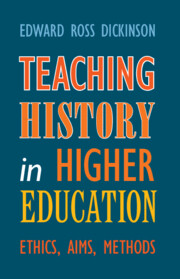Refine search
Actions for selected content:
4 results
Chapter 2 - What Do Historians Do?
-
- Book:
- Teaching History in Higher Education
- Published online:
- 07 February 2025
- Print publication:
- 20 February 2025, pp 61-100
-
- Chapter
- Export citation
Chapter 1 - What Is History Like?
-
- Book:
- Teaching History in Higher Education
- Published online:
- 07 February 2025
- Print publication:
- 20 February 2025, pp 24-60
-
- Chapter
- Export citation

Teaching History in Higher Education
- Ethics, Aims, Methods
-
- Published online:
- 07 February 2025
- Print publication:
- 20 February 2025
Thinking Otherwise: Bringing Young People into Pediatric Concussion Clinical and Research Practice
-
- Journal:
- Brain Impairment / Volume 23 / Issue 1 / March 2022
- Published online by Cambridge University Press:
- 29 November 2021, pp. 104-117
-
- Article
- Export citation
